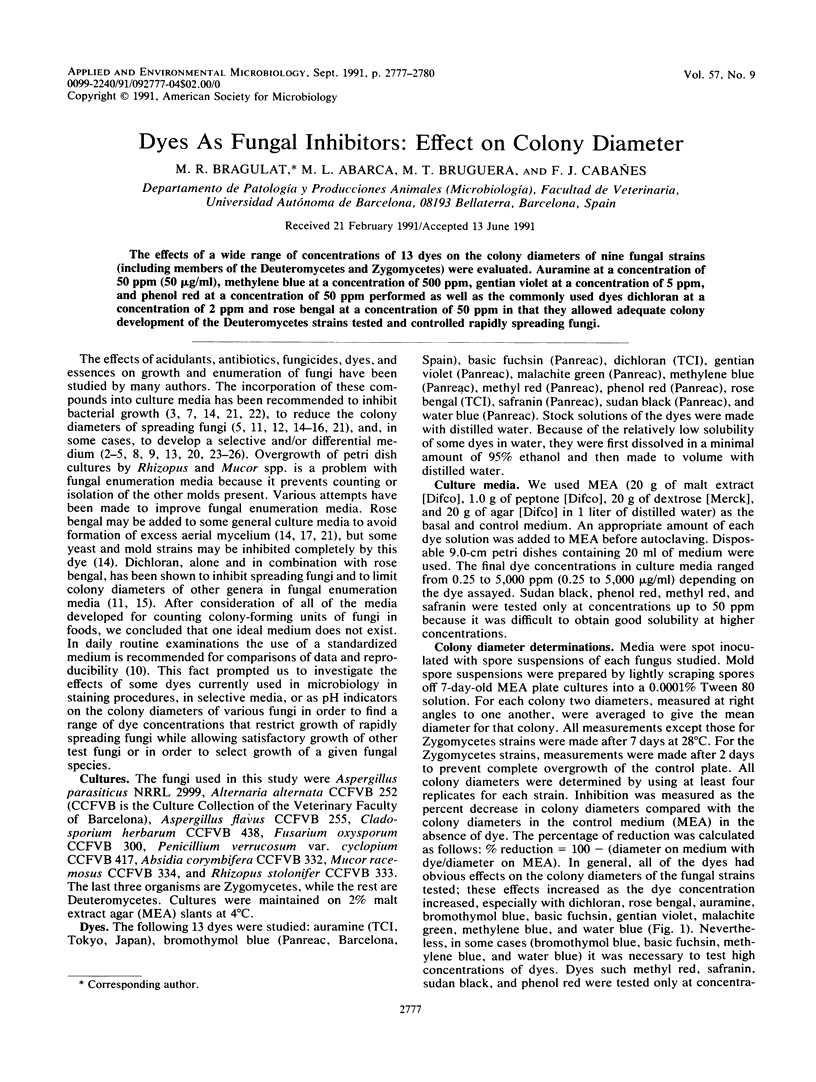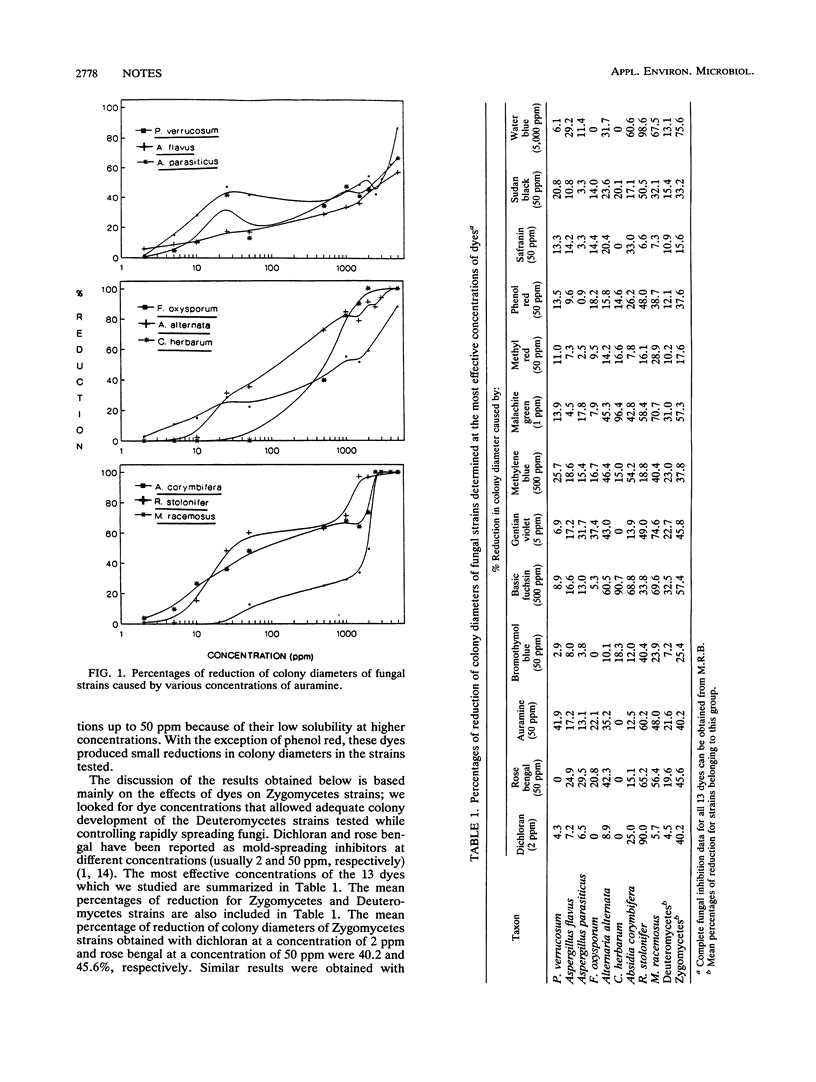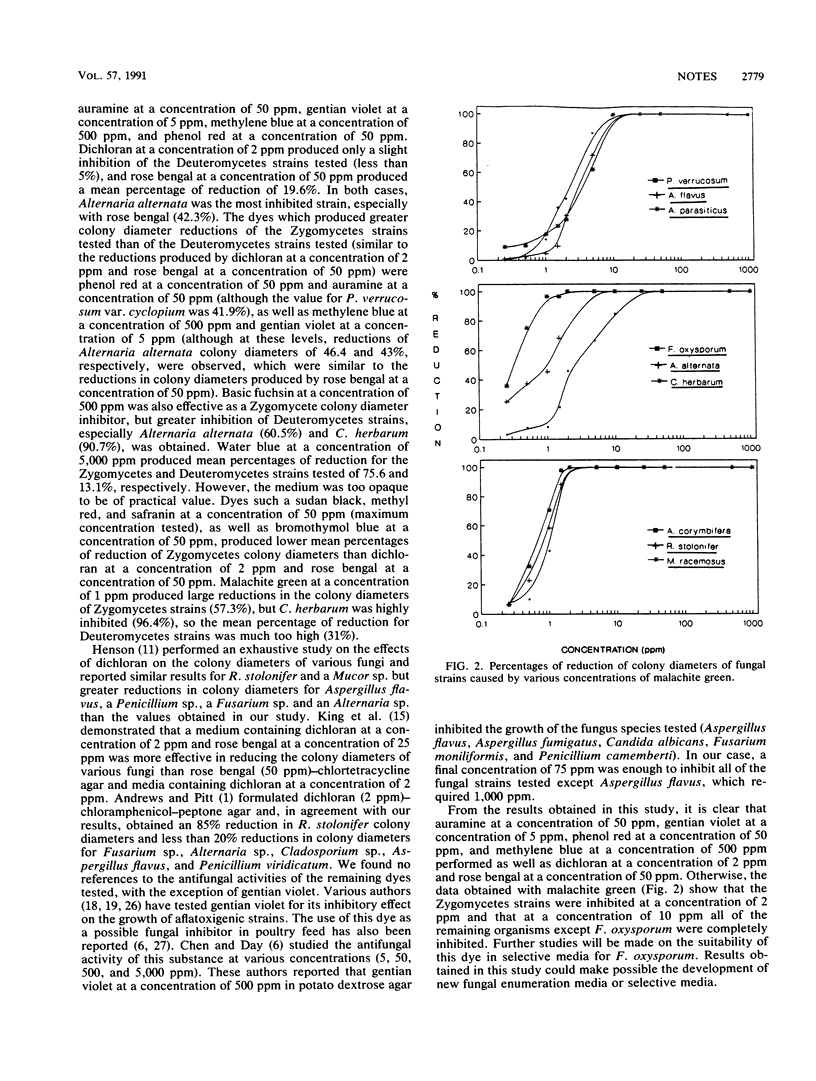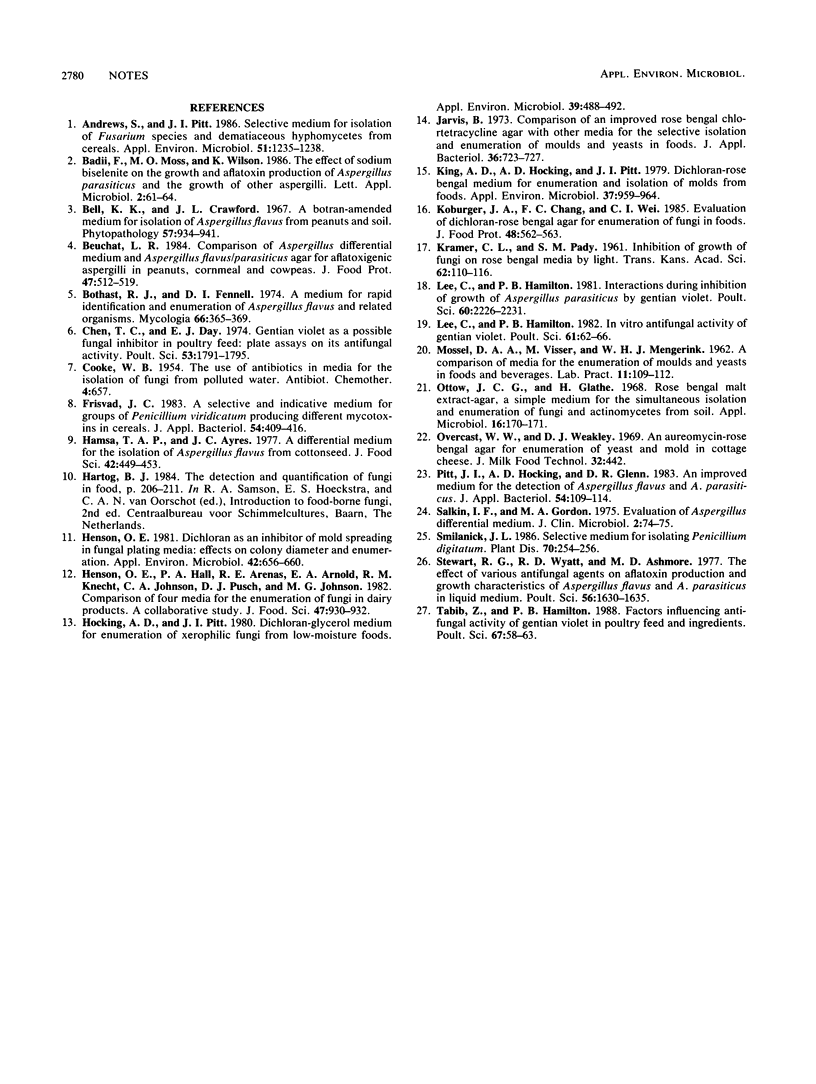Abstract
The effects of a wide range of concentrations of 13 dyes on the colony diameters of nine fungal strains (including members of the Deuteromycetes and Zygomycetes) were evaluated. Auramine at a concentration of 50 ppm (50 micrograms/ml), methylene blue at a concentration of 500 ppm, gentian violet at a concentration of 5 ppm, and phenol red at a concentration of 50 ppm performed as well as the commonly used dyes dichloran at a concentration of 2 ppm and rose bengal at a concentration of 50 ppm in that they allowed adequate colony development of the Deuteromycetes strains tested and controlled rapidly spreading fungi.
Full text
PDF



Selected References
These references are in PubMed. This may not be the complete list of references from this article.
- Andrews S., Pitt J. I. Selective medium for isolation of Fusarium species and dematiaceous hyphomycetes from cereals. Appl Environ Microbiol. 1986 Jun;51(6):1235–1238. doi: 10.1128/aem.51.6.1235-1238.1986. [DOI] [PMC free article] [PubMed] [Google Scholar]
- Bell D. K., Crawford J. L. A botran-amended medium for isolating Aspergillus flavus from peanuts and soil. Phytopathology. 1967 Sep;57(9):939–941. [PubMed] [Google Scholar]
- Bothast R. J., Fennell D. J. A medium for rapid identification and enumeration of Aspergillus flavus and related organisms. Mycologia. 1974 Mar-Apr;66(2):365–369. [PubMed] [Google Scholar]
- Chen T. C., Day E. J. Gentian violet as a possible fungal inhibitor in poultry feed: plate assays on its antifungal activity. Poult Sci. 1974 Sep;53(5):1791–1795. doi: 10.3382/ps.0531791. [DOI] [PubMed] [Google Scholar]
- Frisvad J. C. A selective and indicative medium for groups of Penicillium viridicatum producing different mycotoxins in cereals. J Appl Bacteriol. 1983 Jun;54(3):409–416. doi: 10.1111/j.1365-2672.1983.tb02636.x. [DOI] [PubMed] [Google Scholar]
- Hall C. L., Hamilton P. B. In vitro antifungal activity of gentian violet. Poult Sci. 1982 Jan;61(1):62–66. doi: 10.3382/ps.0610062. [DOI] [PubMed] [Google Scholar]
- Hall C. L., Hamilton P. B. Interactions during inhibition of growth of Aspergillus parasiticus by gentian violet. Poult Sci. 1981 Oct;60(10):2226–2231. doi: 10.3382/ps.0602226. [DOI] [PubMed] [Google Scholar]
- Henson O. E. Dichloran as an inhibitor of mold spreading in fungal plating media: effects on colony diameter and enumeration. Appl Environ Microbiol. 1981 Oct;42(4):656–660. doi: 10.1128/aem.42.4.656-660.1981. [DOI] [PMC free article] [PubMed] [Google Scholar]
- Hocking A. D., Pitt J. I. Dichloran-glycerol medium for enumeration of xerophilic fungi from low-moisture foods. Appl Environ Microbiol. 1980 Mar;39(3):488–492. doi: 10.1128/aem.39.3.488-492.1980. [DOI] [PMC free article] [PubMed] [Google Scholar]
- Jarvis B. Comparison of an improved rose bengal-chlortetracycline agar with other media for the selective isolation and enumeration of moulds and yeasts in foods. J Appl Bacteriol. 1973 Dec;36(4):723–727. doi: 10.1111/j.1365-2672.1973.tb04157.x. [DOI] [PubMed] [Google Scholar]
- KRAMER C. L., PADY S. M. Inhibition of growth of fungi on rose bengal media by light. Trans Kans Acad Sci. 1961;64:110–116. [PubMed] [Google Scholar]
- King A. D., Jr, Hocking A. D., Pitt J. I. Dichloran-rose bengal medium for enumeration and isolation of molds from foods. Appl Environ Microbiol. 1979 May;37(5):959–964. doi: 10.1128/aem.37.5.959-964.1979. [DOI] [PMC free article] [PubMed] [Google Scholar]
- Ottow J. C., Glathe H. Rose bengal-malt extract-agar, a simple medium for the simultaneous isolation and enumeration of fungi and actinomycetes from soil. Appl Microbiol. 1968 Jan;16(1):170–171. doi: 10.1128/am.16.1.170-171.1968. [DOI] [PMC free article] [PubMed] [Google Scholar]
- Pitt J. I., Hocking A. D., Glenn D. R. An improved medium for the detection of Aspergillus flavus and A. parasiticus. J Appl Bacteriol. 1983 Feb;54(1):109–114. doi: 10.1111/j.1365-2672.1983.tb01307.x. [DOI] [PubMed] [Google Scholar]
- Salkin I. F., Gordon M. A. Evaluation of Aspergillus differential medium. J Clin Microbiol. 1975 Jul;2(1):74–75. doi: 10.1128/jcm.2.1.74-75.1975. [DOI] [PMC free article] [PubMed] [Google Scholar]
- Stewart R. G., Wyatt R. D., Ashmore M. D. The effect of various antifungal agents on aflatoxin production and growth characteristics of Aspergillus parasiticus and Aspergillus flavus in liquid medium. Poult Sci. 1977 Sep;56(5):1630–1635. doi: 10.3382/ps.0561630. [DOI] [PubMed] [Google Scholar]
- Tabib Z., Hamilton P. B. Factors influencing antifungal activity of gentian violet in poultry feed and ingredients. Poult Sci. 1988 Jan;67(1):58–63. doi: 10.3382/ps.0670058. [DOI] [PubMed] [Google Scholar]


